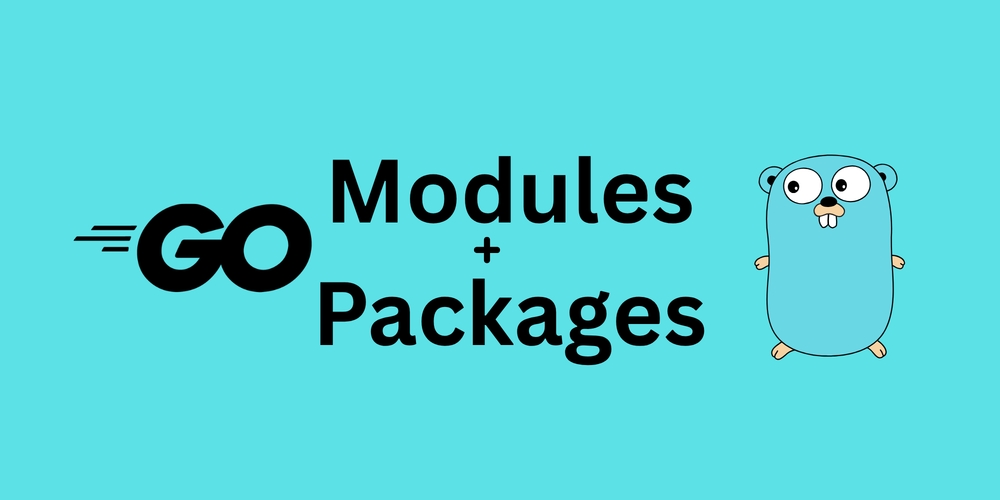Published
- 3 min read
Go Modules & Packages Made Simple: A Beginner-Friendly Guide

Setting up a Go project shouldn’t feel like a puzzle. If you’ve ever wondered how to organize your files, use packages properly, or manage dependencies with Go modules—you’re not alone. In this guide, we’ll break it all down in a practical way, so you can build clean, scalable Go apps with confidence.
What Are Go Modules?
Go modules were introduced in Go 1.11 and became the official dependency management system in Go 1.13. They:
- Eliminate the need for GOPATH
- Support semantic versioning
- Make dependency tracking explicit and reproducible
- Work well with modern version control systems like Git
A Go module is simply a collection of Go packages stored in a file tree with a go.mod file at its root.
module github.com/username/projectname
This module declaration tells Go to import path for your code.
Setting Up Your Module
To initialize a new Go module:
mkdir myproject && cd myproject
go mod init github.com/username/myprojectThis creates a go.mod file. It contains:
- The module path (usually your repository URL)
- The Go version
- Any dependencies your code imports (automatically tracked)
Tip: Run go mod tidy anytime to clean and sync your dependencies.
What Are Go Packages?
In Go, a package is a way to group related code. Each directory with Go source files is considered a package if all files declare the same package name.
Package Rules
- The main package is special—it defines an executable program.
- Other packages define reusable libraries.
Example
// utils/print.go
package utils
import "fmt"
func Hello() {
fmt.Println("Hello from utils")
}To use this package in your main.go:
// main.go
package main
import "github.com/username/myproject/utils"
func main() {
utils.Hello()
}Naming your packages clearly (e.g., math, auth, db) improves code readability.
Folder Structure
A well-structured Go project boosts maintainability. Here’s a popular layout:
myproject/
├── cmd/ # Application entry points
│ └── myapp/
│ └── main.go
├── pkg/ # Public libraries for external use
│ └── utils/
│ └── print.go
├── internal/ # Private application logic
│ └── auth/
├── api/ # API definitions (e.g., Protobuf or OpenAPI)
├── config/ # Configuration and environment setup
├── go.mod # Module definition
├── go.sum # Dependency checksumsWhy use internal/?
The internal/ directory restricts import access to packages within your module only, enforcing encapsulation.
Importing Local and External Packages
External Dependencies
Install with:
go get github.com/gorilla/muxGo automatically adds it to your go.mod and downloads it to your module cache.
Local Packages
Use your module path:
import "github.com/username/myproject/pkg/utils"
Don’t do this:
import "../utils" // Not idiomatic, causes problemsAlways reference local packages using full module-relative paths for consistency and clarity.
Common Mistakes to Avoid
- Using Relative Imports: Always use the full import path from the module root.
- Mixing GOPATH and Modules: Use Go modules exclusively, and work outside of $GOPATH
- Ignoring go mod tidy: Run it often to prune unused dependencies and update go.sum
- Copying vendor/ folders unnecessarily: Use go mod vendor only when needed (e.g., private build environments)
Cheatsheet
# Project Setup:
go mod init <module-name> # Initialize a new module
go mod tidy # Add missing and remove unused dependencies
go mod vendor # Create a vendor directory with dependencies
# Dependency management:
go get example.com/pkg # Add latest version of pkg
go get example.com/[email protected] # Add specific version
go get -u # Update all dependencies
go get -u ./... # Update all dependencies recursively
go list -m all # List all modules
go list -m -u all # List modules with available updates
#Inspect Modules:
go mod why <pkg> # Explain why a dependency is needed
go mod graph # Show module dependency graphFinal Thoughts
Once you master Go modules and packages, organizing, scaling, and collaborating on Go projects becomes seamless.
Pro tip: Use tools like golangci-lint, gopls, and goimports for productivity.